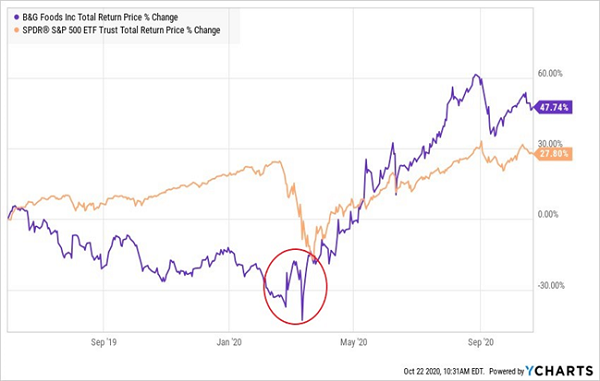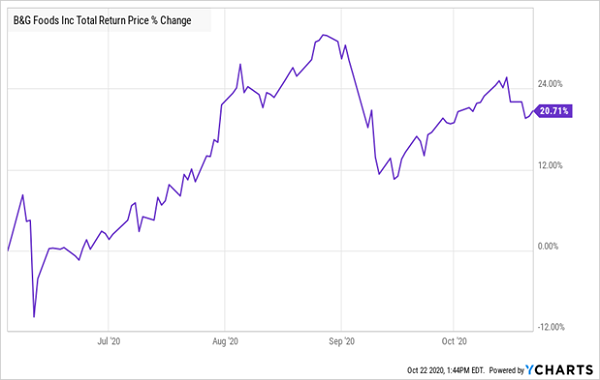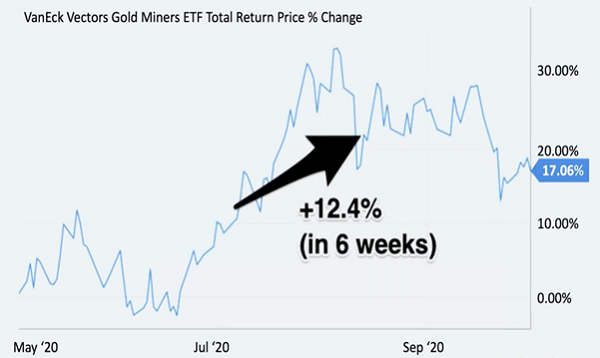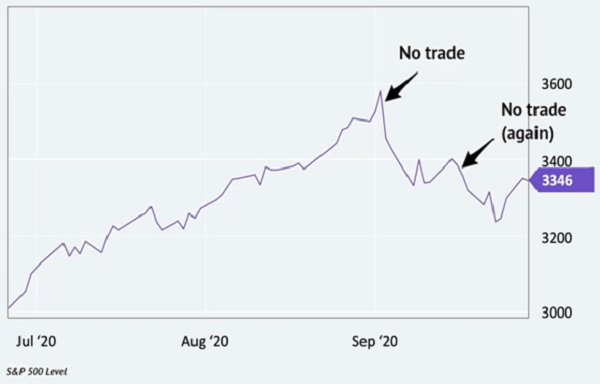It’s rare when we get not one but two crashes bigger than 10%+ in a single year—but hey, it’s 2020. Anything goes.
But take just a second and imagine that you dodged both of those disasters, resting easily on the sidelines during the chaos. Then you moved into stocks for the rest of the year. In that case, 2020 just may be your best year yet!
A “Dream” Strategy (That’s Possible to Achieve!)

Of course, no one can precisely predict the market’s next move. But what I’m about to show you is as close as I’ve ever seen an investing system get. In fact, I custom-built the indicators that drive this powerful tool precisely for 2020’s wild markets.
I call it Dividend Swing Trader. It works like this: we buy into a big dividend just as the underlying stock is set to take off. Then we ride its momentum higher and flip to cash—locking in our price gain and taking some nice dividend cash with us, too!
(A small group of savvy investors has been grabbing big upside, and big dividends, from this service already; I’ll give you a chance to join them, with no obligation, at the end of this article.)
To make it work, we look for stocks with two simple things:
- A big dividend that’s either growing now or has the potential to spring higher, thanks to a company’s soaring cash flow, sturdy balance sheet or low payout as a percentage of free cash flow (FCF)—and ideally all three.
- “Relative strength”: This means that strong stocks tend to stay strong, giving them a solid base from which to jump. Forget the bargain bin—we’re not necessarily looking for low P/E ratios here—just stocks that have momentum, driven by surging trends in society and their sector.
I know this sounds a bit abstract, so let’s dive into an actual Dividend Swing Trader move that handed us a gaudy 21% gain (with a big slice of that in dividends!) in under five months.
Step 1: Look for Stocks With “Relative Strength”
Back in March, B&G Foods (BGS)—maker of frozen and packaged fare like Green Giant peas and Cream of Wheat cereal—did something odd: after trailing the market for most of 2019, it bottomed before the S&P 500 in the spring, then started gapping higher.
That made sense: with restaurants out of the picture for many folks, shoppers were stocking up on non-perishable foods. This checked our “relative strength” box and was my first tip that B&G was setting up for a fast run higher. Look at this chart:
B&G’s “Relative Strength” Begins to Show

That led us to …
Step 2: Look for a High Dividend With Growth Ahead
With a big price gain setting up, we dug deeper into the dividend—and found a safe, massive payout that looked primed for growth. B&G shares yielded a gaudy 7.8% when we bought, and the dividend was backstopped by an ultra-safe payout ratio of just over 50% of free cash flow (FCF).
Step 3: BUY
With all these winning elements in place: a high current yield, a safe dividend with the potential to grow (and attract more investors!) and a base of relative strength, it was time to make our move. On June 4, I issued a buy call to our small crew of Dividend Swing Trader members.
Here’s what happened next:
An Entire Year’s Worth of Gains—in Less Than 5 Months!

Let me tell you something here: a 21% return is what we look for from our Dividend Swing Trader portfolio on a yearly basis. B&G delivered that in less than five months—and with a quarter of that return in safe dividend cash!
Most advisors will tell you that such a performance by a stock that yields 7.8% is impossible. But there it is.
And we didn’t get down in the weeds with our short-term B&G trade, getting tied up with P/E ratios, PEG ratios, price-to-sales ratios or whatever your preferred valuation measure is. We simply looked for a healthy, high dividend and that relative strength I talked about earlier. That’s it.
Sometimes You Win on Relative Strength Alone
In fact, relative strength is so powerful that it can sometimes drive you to a fast double-digit profit all on its own.
Take gold, a go-to for many folks in a crisis—especially a crisis that has anything to do with inflation. And a strong trigger of inflation is a wave of money printing fiscal stimulus like the one Fed Chair Jay Powell unleashed last spring:
Powell’s Wave of Instant Money

Sure enough, gold began to gap higher. Trouble was, I didn’t have a high-yield play on the trend, as most gold miners pay low dividends. That meant it wouldn’t work for my Contrarian Income Report service, whose portfolio yields 8%, on average. I also knew this was likely to be a short-term trade, and CIR members like to draw on their 8%+ payouts for months—and often years.
But it was perfect for my Dividend Swing Trader group. So we went after the gold miners through the Van Eck Gold Miners ETF (GDX), which only yielded about 0.5% but whose relative strength was just starting to appear when we pounced on July 2. Six weeks later, on August 13, we checked out with a fast 12.4% gain.
Riding “Relative Strength” to Another Quick Win

As you can see, it was the right time to exit. GDX then drifted sideways before moving lower this fall, as the September stock selloff took gold down with it.
Stepping in During the Lows—and Out During the Highs
That’s a perfect segue to the other half of our Dividend Swing Trader strategy—protecting your cash.
In September, my indicators told me a pullback was due, so we held off on any new trades. We entered the correction with our portfolio half in cash and the other half weighted toward “low beta” stocks, or those that are less volatile than your typical S&P 500 name. Those would be stocks like B&G Foods, whose 7.8% income stream kept on flowing through to us uninterrupted!
Pulling in Our Sails Before the Storm Hits

A Careful, Nimble Approach (With a Dividend Kicker)
Before I give you an opportunity to try out Dividend Swing Trader yourself, there are two things you should know about the service.
The first is that our DST picks pay dividends far in excess of those of typical S&P 500 stocks—the stocks and funds in our portfolio now throw off an average 5% dividend. Cherry-pick the three highest payers and you’ll get payouts of 6.8%, 8.3% and 8.4%.
The second, as you can probably tell, is that we aren’t following a “buy and hold” strategy here, where we keep our positions for years. Instead, as you saw with GDX and B&G, we’ll buy in so that we catch the bulk of a major move up (and collect our dividend payouts), then make our exit, taking our gains (and dividends!) with us.
The final step? Roll our gains into another high yielder set to soar. Rinse and repeat.
Double-Digit Yearly Returns (Forever!)—These 7 Amazing Stocks Get You There.
Due to a surge in demand, we’ve had to close the rolls of our Dividend Swing Trader service for now (to keep DST small and nimble, I have to keep a tight lid on its subscriber count).
But don’t worry, I’m not going to leave you hanging—I recently released another selection of fast-moving picks you’ll definitely want to put on your buy list. These are my 7 top dividend-growth-stocks, and I want to give you instant access to those right now.
These 7 picks are so far off the radar I’ve dubbed them “hidden yield” stocks. They all have one thing in common: they’re quietly handing investors growing income streams plus annual returns of 15%, 17.3%, 20.8% or more.
These 7 buys are perfectly positioned to post steady gains through the rest of this crisis and double when we get to the other side. All 7 boast rising free cash flow, deep order backlogs and “fortress” balance sheets—a trifecta of strengths no pandemic, financial crisis or trade war can breach.
I’m calling for 15%+ annualized returns from these 7 “crisis-resistant” dividend plays. That’s enough to double your nest egg every 5 years!
Full details on these 7 standout buys are waiting for you now. Click here to get my complete research: names, tickers, dividend histories and a full breakdown of their operations—everything you need to buy with confidence.
